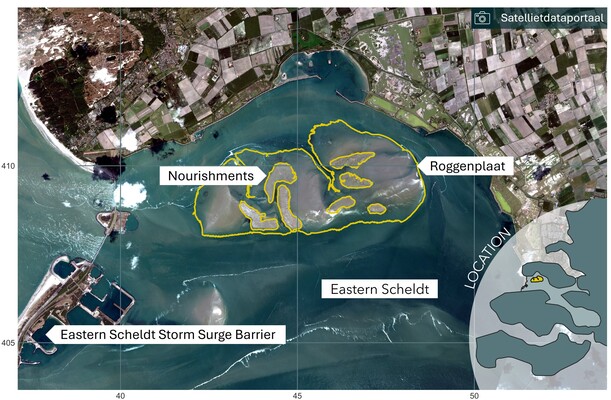N.P. Vermeer1*, P.L.M. de Vet1, A.T.M. de Bakker1, J.J. van der Werf1,2, V. Escaravage3, S. van Donk3, J. van Belzen3,4, T. Grandjean4, B. Walles4, H. de Looff5, K. Buis5.
1Deltares, the Netherlands; 2University of Twente, the Netherlands; 3Wageningen Marine Research, the Netherlands; 4NIOZ, the Netherlands; 5Rijkswaterstaat, the Netherlands
*corresponding author: nienke.vermeer@deltares.nl
Introduction
The construction of the Eastern Scheldt storm surge barrier (1986) resulted in intertidal flat erosion. This has negative effects on the natural as well as other values of the Eastern Scheldt. Primarily because the intertidal areas serve as a resting and foraging area for birds, marine mammals, and fish.
In the autumn of 2019, a large-scale nourishment (1.13 Mm3) was accomplished on the Roggenplaat (Eastern Scheldt), to mitigate the losses of bird foraging area. This Roggenplaat nourishment consists of seven elements, with each element being unique in terms of their location, elevation, and thickness of the sediment layer. Rijkswaterstaat, together with WMR, Deltares, NIOZ and Deltamilieu Projecten, have been extensively monitoring the Roggenplaat since 2015 to evaluate the eco-morphological evolution of this nourishment and to gather understanding on the mechanisms involved. These insights enable eco-morphological optimization of future nourishments in the Eastern Scheldt.
Objective and Methods
The monitoring of the Roggenplaat was focused on assessing the effects of the nourishments on hydrodynamics, morphodynamics, and ecology. In addition to evaluating the nourishments, we focussed on understanding the underlying processes such that differences in evolution of the nourishment elements could be explained.
The morphological monitoring employed a range of techniques to collect comprehensive data. These included LiDAR for high-resolution terrain mapping and RTK for precise topographic survey location data. SED sensors tracked sediment dynamics and transport, while sediment sampling provided insights on sediment composition (e.g., mud fraction). Additionally, multibeam SONAR was utilized to produce detailed bathymetric maps of the two major tidal creeks through the Roggenplaat. These monitoring data have been used to evaluate the morphological development of the Roggenplaat and the nourishments over the first five years after construction (2020-2024).
Results
The morphological data indicate that the area with an exposure time exceeding 50% (especially beneficial for the birds) increased by 16% due to the nourishments aligned with the nourishment design (Van der Werf et al., 2016). Post-nourishment, the area with an exposure time of 50-80% decreased, while the area with an exposure time of more than 80% completely disappeared. The largest changes occurred within the first year. Location played a crucial role, with southern nourishments (more exposed to waves) experiencing more erosion than the more sheltered northern nourishments. The nourishments migrated predominantly towards the north/northeast along the direction of the prevailing winds, and there was a tendency for the initially steep bed slopes to flatten. Additionally, creeks developed between the nourishments. The nourishments were constructed with relatively coarse sand, which showed some refining over past years. Still, the grain size on the nourishments remained coarser than in the pre-nourishment situation. This evolution is generally in line with the expectations during the design phase. However, further morphological optimizations (e.g., regarding grain size) remain important in ensuring maximal ecological potential of future nourishments.

Satellite image from April/May 2020 depicting the Roggenplaat in the Eastern Scheldt, the Netherlands. The (former) Island of Schouwen is located to the north, while the Eastern Scheldt Storm Surge Barrier lies to the west. The contours of the Roggenplaat and the nourishments are highlighted in yellow.
References
Van der Werf, J.J., De Vet, P.L.M., Boersema, M.P., Bouma, T.J., Nolte, A.J., Schrijvershof, R.A., Soissons, L.M., Stronkhorst, J., Van Zanten, E., Ysebaert, T., 2019. An integral approach to design the Roggenplaat intertidal shoal nourishment. Ocean & coastal management, 172, 30-40.










